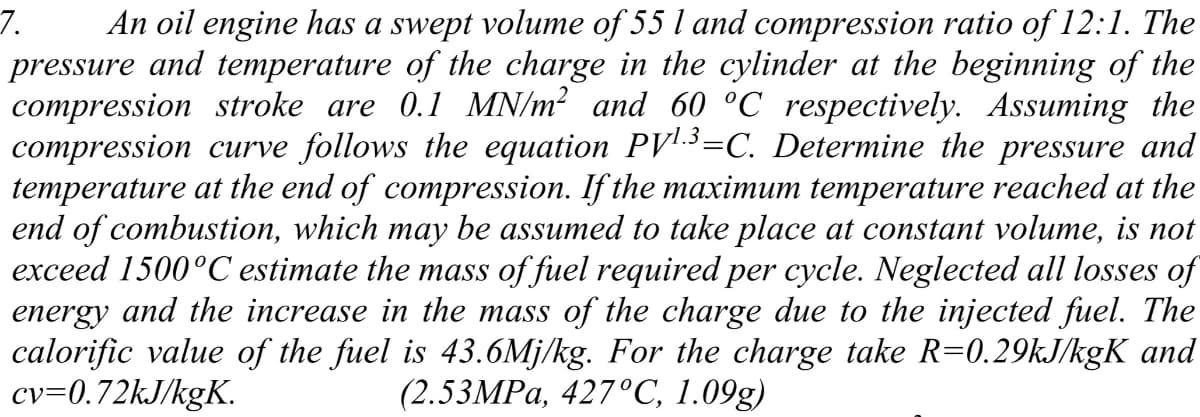An oil engine has a swept volume of 55 l and compression ratio of 12:1. The pressure and temperature of the charge in the cylinder at the beginning of the compression stroke are 0.1 MN/m² and 60 °C respectively. Assuming the compression curve follows the equation PV3=C. Determine the pressure and temperature at the end of compression. If the maximum temperature reached at the end of combustion, which may be assumed to take place at constant volume, is not exceed 1500°C estimate the mass of fuel required per cycle. Neglected all losses of energy and the increase in the mass of the charge due to the injected fuel. The calorific value of the fuel is 43.6Mj/kg. For the charge take R=0.29kJ/kgK and cv=0.72kJ/kgK. 7. (2.53MPA, 427°C, 1.09g)
An oil engine has a swept volume of 55 l and compression ratio of 12:1. The pressure and temperature of the charge in the cylinder at the beginning of the compression stroke are 0.1 MN/m² and 60 °C respectively. Assuming the compression curve follows the equation PV3=C. Determine the pressure and temperature at the end of compression. If the maximum temperature reached at the end of combustion, which may be assumed to take place at constant volume, is not exceed 1500°C estimate the mass of fuel required per cycle. Neglected all losses of energy and the increase in the mass of the charge due to the injected fuel. The calorific value of the fuel is 43.6Mj/kg. For the charge take R=0.29kJ/kgK and cv=0.72kJ/kgK. 7. (2.53MPA, 427°C, 1.09g)
Elements Of Electromagnetics
7th Edition
ISBN:9780190698614
Author:Sadiku, Matthew N. O.
Publisher:Sadiku, Matthew N. O.
ChapterMA: Math Assessment
Section: Chapter Questions
Problem 1.1MA
Related questions
Question

Transcribed Image Text:7.
An oil engine has a swept volume of 55 l and compression ratio of 12:1. The
and temperature of the charge in the cylinder at the beginning of the
pressure
compression stroke are 0.1 MN/m? and 60 °C respectively. Assuming the
compression curve follows the equation PV!-.3=C. Determine the pressure and
temperature at the end of compression. If the maximum temperature reached at the
end of combustion, which may be assumed to take place at constant volume, is not
exceed 1500°C estimate the mass of fuel required per cycle. Neglected all losses of
energy and the increase in the mass of the charge due to the injected fuel. The
calorific value of the fuel is 43.6Mj/kg. For the charge take R=0.29kJ/kgK and
cv=0.72kJ/kgK.
(2.53MPA, 427°C, 1.09g)
Expert Solution
This question has been solved!
Explore an expertly crafted, step-by-step solution for a thorough understanding of key concepts.
Step by step
Solved in 4 steps with 1 images

Knowledge Booster
Learn more about
Need a deep-dive on the concept behind this application? Look no further. Learn more about this topic, mechanical-engineering and related others by exploring similar questions and additional content below.Recommended textbooks for you

Elements Of Electromagnetics
Mechanical Engineering
ISBN:
9780190698614
Author:
Sadiku, Matthew N. O.
Publisher:
Oxford University Press

Mechanics of Materials (10th Edition)
Mechanical Engineering
ISBN:
9780134319650
Author:
Russell C. Hibbeler
Publisher:
PEARSON

Thermodynamics: An Engineering Approach
Mechanical Engineering
ISBN:
9781259822674
Author:
Yunus A. Cengel Dr., Michael A. Boles
Publisher:
McGraw-Hill Education

Elements Of Electromagnetics
Mechanical Engineering
ISBN:
9780190698614
Author:
Sadiku, Matthew N. O.
Publisher:
Oxford University Press

Mechanics of Materials (10th Edition)
Mechanical Engineering
ISBN:
9780134319650
Author:
Russell C. Hibbeler
Publisher:
PEARSON

Thermodynamics: An Engineering Approach
Mechanical Engineering
ISBN:
9781259822674
Author:
Yunus A. Cengel Dr., Michael A. Boles
Publisher:
McGraw-Hill Education

Control Systems Engineering
Mechanical Engineering
ISBN:
9781118170519
Author:
Norman S. Nise
Publisher:
WILEY

Mechanics of Materials (MindTap Course List)
Mechanical Engineering
ISBN:
9781337093347
Author:
Barry J. Goodno, James M. Gere
Publisher:
Cengage Learning

Engineering Mechanics: Statics
Mechanical Engineering
ISBN:
9781118807330
Author:
James L. Meriam, L. G. Kraige, J. N. Bolton
Publisher:
WILEY